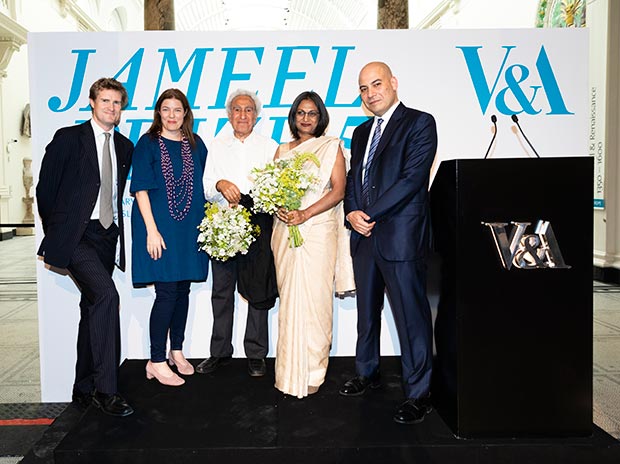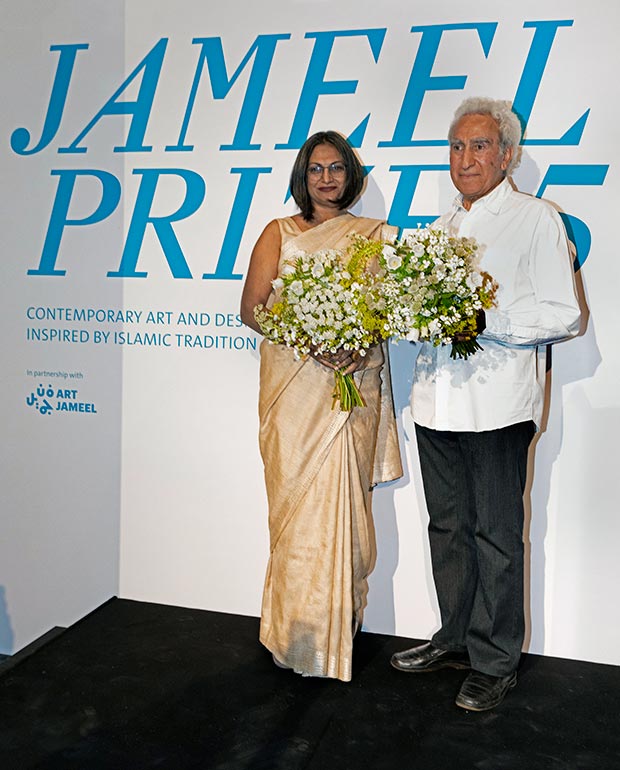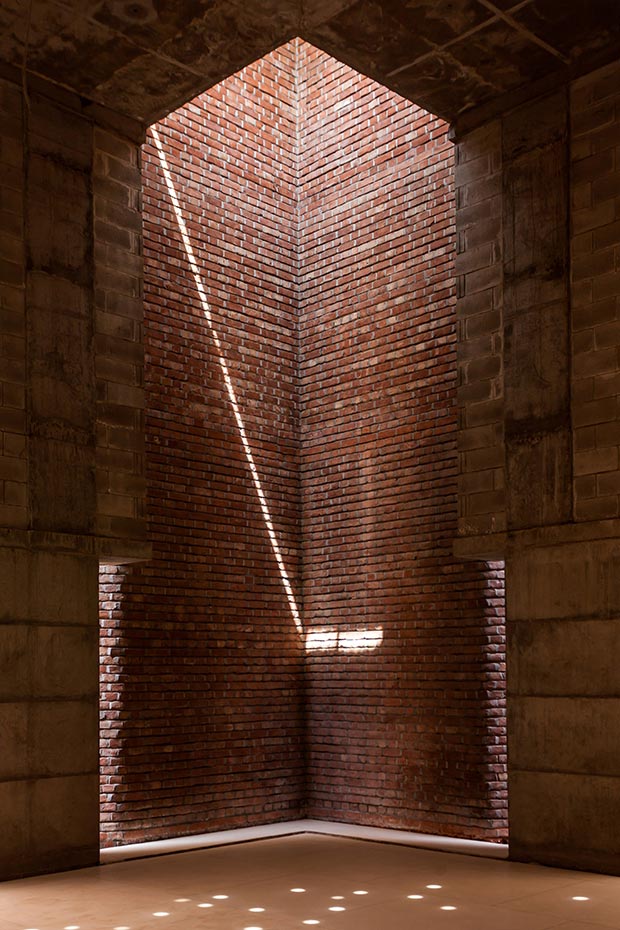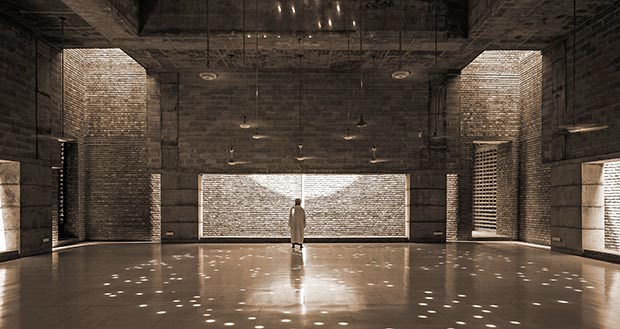
Jameel Prize 5 Mehdi Moutashar and Marina Tabassum - First Ever Joint Winners of Jameel Prize 5
Jul 04, 2018 Awards

 Tristram Hunt, Director of the V&A, Antonia Carver, Director, Art Jameel, Mehdi Moutashar, Marina Tabassum and Fady Jameel, President, Art Jameel / Photo courtesy of V&A
Tristram Hunt, Director of the V&A, Antonia Carver, Director, Art Jameel, Mehdi Moutashar, Marina Tabassum and Fady Jameel, President, Art Jameel / Photo courtesy of V&A
Mehdi received the award for his four bold works of minimalist abstraction rooted in Islamic geometry, and Marina for her visionary Bait ur Rouf Mosque built in 2012 in Dhaka, Bangladesh. Both winners’ achievement has been to produce work of outstanding quality and contemporary relevance while demonstrating a profound understanding of the cultures from which they come. The judges felt that although working in very different fields, the joint winners had both shown the same combination of lucidity and sophistication in drawing on Islamic tradition.
 Jameel Prize 5 winners Marina Tabassum and Mehdi Moutashar / Photo courtesy of V&A
Jameel Prize 5 winners Marina Tabassum and Mehdi Moutashar / Photo courtesy of V&A
Tristram Hunt, Director of the V&A and chair of judging panel, said: “This edition, selecting one winner proved extremely difficult, due to the very high standard of work in the exhibition. The joint Jameel Prize 5 winners are both in dialogue with contemporary global discourses on art and have produced exemplary work in two very different disciplines. They show an awareness of modernist practices of the 20th century, which have in turn drawn on traditions from around the world. At the same time, though, they are passionately rooted in and deeply learned about their own cultural legacies.â€
Mehdi Moutashar left Iraq in the late 1960s and settled in Paris, where he encountered forms of minimalism, including geometric abstraction. He has developed these ideas, integrating them with the Islamic traditions of his native land to create a powerful personal language that has depth, wit and urgency. The judges agreed that he should be considered among the greatest living exponents of a constructivist aesthetic.
 Mehdi Moutashar, Un carré et trois angles droits. (A square and three right angles, 2016. Metal and elastic wire. Collection of the artist. Photography © Mehdi Moutashar
Mehdi Moutashar, Un carré et trois angles droits. (A square and three right angles, 2016. Metal and elastic wire. Collection of the artist. Photography © Mehdi Moutashar
 Mehdi Moutashar, Deux carrésdont un encadré [Two squares, one of them framed] (2017). Wood, paint, elastic wire. Collection of the artist, Photo © Fabrice Leroux
Mehdi Moutashar, Deux carrésdont un encadré [Two squares, one of them framed] (2017). Wood, paint, elastic wire. Collection of the artist, Photo © Fabrice Leroux
Marina Tabassum is an architect based in Dhaka, Bangladesh. The Bait ur Rouf Mosque draws on medieval Islamic architecture and celebrates the building traditions of Bengal. The mosque is a wonder in its play with geometry, abstraction, light, air and water, making it both an animated and contemplative space. Its functions answer the needs of the local community, and it is a composition of local materials and contemporary techniques, responsive to both its environment and to history. The building positions Marina as a contemporary architect of great insight and imagination.â€
 Marina Tabassum, 08. Light and Spirituality. Photo by Hassan Saifuddin Chandan. © MTA/Hasan Saifuddin Chandan
Marina Tabassum, 08. Light and Spirituality. Photo by Hassan Saifuddin Chandan. © MTA/Hasan Saifuddin Chandan
 Marina Tabassum, Prayer Hall, Bait urRouf Mosque. Dhaka, Bangladesh (2012). Photo: Sandro di Carlo Darsa, © MTA/Sandro di Carlo Darsa
Marina Tabassum, Prayer Hall, Bait urRouf Mosque. Dhaka, Bangladesh (2012). Photo: Sandro di Carlo Darsa, © MTA/Sandro di Carlo Darsa
An exhibition of work by the winner and six other short-listed artists and designers runs until 25 November 2018 at the V&A. They are Kamrooz Aram, Hayv Kahraman, Hala Kaiksow, naqsh collective, Younes Rahmoun and Wardha Shabbir. Awarded every two years, the Jameel Prize, founded in partnership with Art Jameel, is a £25,000 international art prize for contemporary artists and designers inspired by Islamic tradition.
The winner was decided by a panel of judges chaired by Tristram Hunt, Director of the V&A. The judges are Salah Hassan, Professor and Director, Institute for Comparative Modernities at Cornell University, New York; design historian Tanya Harrod; November Paynter who is Director of Programs at the Museum of Contemporary Art in Toronto; and the artist Ghulam Mohammad, who was winner of Jameel Prize 4.
Launched in 2009, the winner of the first Jameel Prize was Afruz Amighi for her work 1001 Pages (2008), an intricate hand-cut screen made from the woven plastic used to construct refugee tents. In 2011 Rachid Koraïchi was awarded the prize for his work Les Maîtres Invisibles (The Invisible Masters, 2008), a group of embroidered cloth banners which display Arabic calligraphy and symbols and ciphers to explore the lives and legacies of the 14 great mystics of Islam. In 2013 the winner of Jameel Prize 3 was Dice Kayek, a Turkish fashion label established in 1992 by Ece and Ayşe Ege for their series Istanbul Contrast, a collection that evokes Istanbul’s architectural and artistic heritage. This was the first time the Jameel Prize was awarded to designers. In 2016, the winner of Jameel Prize 4 was Ghulam Mohammad, who trained in the Islamic tradition of miniature painting, for his works of paper collage.
The Jameel Prize was conceived after the renovation of the V&A’s Jameel Gallery of Islamic Art, which opened in July 2006 to present the rich artistic heritage of the Islamic world. The prize aims to raise awareness of the thriving interaction between contemporary practice and this great historical heritage and to broaden understanding of Islamic culture and its place in the world.
The Jameel Prize 5 exhibition is curated by Tim Stanley, senior curator of the V&A’s great historical collection from the Islamic Middle East, with Salma Tuqan, the V&A’s curator of contemporary art and design from the region.
Comments
Add a comment